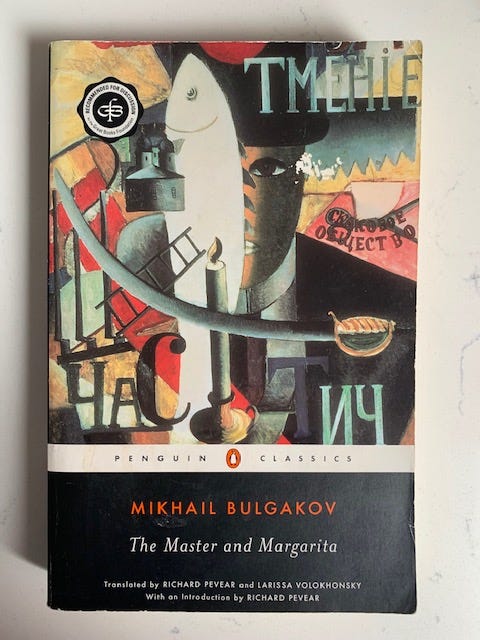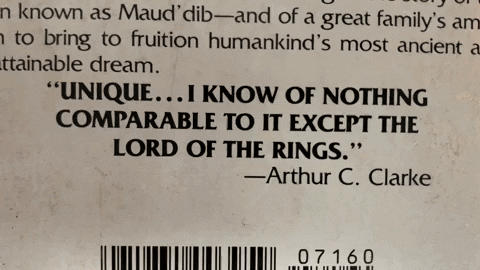'The Master and Margarita' by Mikhail Bulgakov
'”You lose!” bawled the cat. “Hurrah!”'—Review #169

I hope you are all enjoying the first weekend of fall like:
Autumn is my favorite time of year. It means cool weather, hot tea and jaunty scarves. It’s also the beginning of spooky season, and we’re kicking it off with ‘The Master and Margarita’ by Mikhail Bulgakov. This posthumously published novel1 is often described as a 20th-century masterpiece that satirizes Soviet Russia with a strange and fantastical story that includes witches on broomsticks, goth dance parties, Biblical figures, a gun-toting cat and the Prince of Darkness himself.
Here’s the cover:

Click ♥️ if you enjoy this review. ⬆️
Satan has come to Moscow to throw his annual gala for doomed souls. To arrange this, he and his henchmen—Azazello, an enforcer with one fang, Koroviev, a fast-talker with a cracked pince-nez, and Behemoth, a cat that can walk and talk like a person—go on a bizarre spree of murder and mayhem. They clear out an apartment suitable for the festivities by sending one resident under a tram and teleporting another to Yalta. They distract the police by staging a black-magic séance that ends with people running wild, some of them nearly naked, in the streets. They confound the state bureaucracy by causing an office staff to break out in uncontrollable song, and they turn one bureaucrat invisible: a literal empty suit. Interspersed with the demonic hijinks is a story about Pontius Pilate, the trial and execution of Jesus Christ and its aftermath. Connecting these threads is the plight of the master and Margarita. The master is a writer working on a novel about Pontius Pilate (the scenes involving him are excerpts from the manuscript), and he winds up locked in an asylum. Margarita is the master’s lover who agrees to serve as the hostess of Satan’s upcoming rave so long as he frees the master. Confused? I was. There’s a lot going on here, and often my head was spinning like:
I used to see this book everywhere on the subway in the before times. When I found this edition at Housing Works earlier this year, I snagged it. But I struggled to get into the story, and worried that I might not finish it. I even took a break to read another book. But things definitely picked up in the second half once Margarita rubs invisibility cream on herself, mounts a flying broomstick and takes revenge on the master’s enemies. That was a fun sequence, especially when she encounters a flying pig ridden by her maid. Better still was near the end of the book when Behemoth (my favorite character, as you can see by all the cat GIFs) got into a hilarious gun battle with the police, like:
I’ve enjoyed thinking about what Bulgakov might have been saying through his weird and complex story. I think he was using ‘The Master and Margarita’ to explore state power and human fear. Pilate famously absolves himself from responsibility for a man’s execution. Here we see how the consequences of that decision might weigh on a man’s mind and soul. Bulgakov seems to ask: Can we rely on a leader to have the moral courage to do what is right? Who gets to define that? Pilate also asked Jesus: What is truth? How often have we seen objective facts cast aside, and politicians go along? And then there’s the devil, who here is less of an evil figure and more of a provocateur and exposer of hypocrisy. Through the fear generated by the mayhem he and his retinue cause, we see that citizens will seek the refuge of the state, even asking to be detained and jailed, so long as they feel safe and secure. Things to chew on for sure, but I leave definitive meanings to folks smarter than me, like:
‘The Master and Margarita’ is a funny, unique, bizarre and thought-provoking novel. I’m glad I stuck with it. The payoff was great. If you’re up for reading a challenging classic, you should check out this book.
How it begins:
At the hour of the hot spring sunset two citizens appeared at the Patriarch’s Ponds. One of them, approximately forty years old, dressed in a grey summer suit, was short, dark-haired, plump, bald, and carried his respectable fedora hat in his hand. His neatly shaven face was adorned with black horn-rimmed glasses of a supernatural size. The other, a broad-shouldered young man with tousled reddish hair, his checkered cap cocked back on his head, was wearing a cowboy shirt, wrinkled white trousers and black sneakers.
The first was none other than Mikhail Alexandrovich Berlioz, editor of a fat literary journal and chairman of the board of one of the major Moscow literary associations, called Massolit for short, and his young companion was the poet Ivan Nikolaevich Ponyrev, who wrote under the pseudonym of Homeless.
Once in the shade of the barely greening lindens, the writers dashed first thing to a brightly painted stand with the sign: ‘Beer and Soft Drinks.’
Ah, yes, note must be made of the first oddity of this dreadful May evening. There was not a single person to be seen, not only by the stand, but also along the whole walk parallel to Malaya Bronnaya Street. At that hour when it seemed no longer possible to breathe, when the sun, having scorched Moscow, was collapsing in a dry haze somewhere beyond Sadovoye Ring, no one came under the lindens, no one sat on a bench, the walk was empty.
My rating:

‘The Master and Margarita’ by Mikhail Bulgakov was originally published as ‘Master i Margarita’ in serial form in ‘Moskva’ from 1966-67. This translation from the Russian by Richard Pevear and Larissa Volokhonsky was published in 1997 by Penguin Classics. 412 pages including notes. $16.56 at Bookshop.org.
Let’s discuss:
What was a book you almost gave up on that you stuck with and ended up liking?
What’s next:
Tell a friend about Books on GIF.
Before you go:
ICYMI: Review #168 featured ‘The Story’ by A’Ziah King | Browse the Archive
Read this: ‘“I have a lot of questions for you”: Elena Ferrante talks to Marina Abramović'’ in the Financial Times features an engaging exchange between the famously reclusive writer and the famously present performance artist. It is a fascinating glimpse into their processes and thoughts, and it was great to see them challenge each other about art and what it means to be a female artist in a male-centered art world. Definitely worth a read.
Click this: Books on GIF subscribers are sharing the books they are most excited to read this fall. Join the conversation!
And NBD, but:
Thanks for reading, and thanks especially to Donna for editing this newsletter!
Until next time,

MPV
Newsletters you ♥️ the most
The introduction by Richard Pevear, one of the novel’s translators, is definitely worth a read. He talks about how the story came together over several decades in Stalin’s Russia, and how Bulgakov’s widow worked to get the manuscript published two decades after the author’s death.










I was reading The Master and Margarita at an upstate ski mountain while my kids were taking lessons (it was too cold for me to ski:)). A man approached me and told me he met his wife when she was reading it and they subsequently fell in love an married, partly based on their mutual love of the book. I liked it and we had a good book club meeting about it, but I was always surprised that this was a book that drew a couple to each other.
Excellent review! And I loved the cats!!
The Master and Margarita is one of my favorite books. I'm a giant Russian history/lit nerd, and it's just such a fascinating example of literature as criticism of the state.